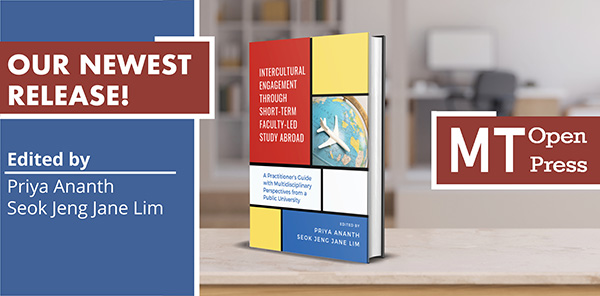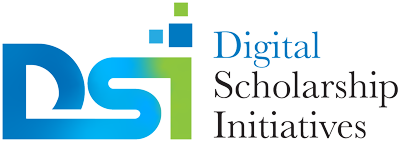Announcing the Final Projects for the Digital Seed Grants 2022-2023
The Digital Seed Grant (https://dsi.mtsu.edu) had impressive applications for its sixth year. The Digital Seed Grant Review Committee and Library Dean decided to award four grants for the 2022-2023 academic year. The AY 22-23 awardees were announced on the website at https://dsi.mtsu.edu/dsgrant22-23.
Below is a summary of the four winning projects and resulting outcomes. A PDF copy of the full report details is preserved in the institutional repository.
Congratulations to the project investigators and their teams on the completion of these projects!
Intercultural Engagement in Short-Term Faculty-Led Study Abroad Programs Across Disciplines
Primary Investigator (PI): Dr. Priya Ananth, MTSU Department of World Languages, Literatures, and Cultures
PI’s Project Description: The Digital Seed Grant was used to fund the copyediting, print book purchases, and student worker support for producing an open access book titled Intercultural Engagement Through Short-Term Faculty-Led Study Abroad: A Practitioner’s Guide with Multidisciplinary Perspectives from a Public University. The monograph is edited by Priya Ananth and Seok Jeng Jane Lim, aided by 15 contributing chapter authors, and published by MT Open Press.
The main objective of this edited volume is to offer pedagogically sound and creative ways of integrating elements of intercultural competence into class activities, tasks, and assignments in short-term faculty-led study abroad programs. The intercultural competencies, categorized in the areas of knowledge, skills, and attitudes, include characteristics such as awareness about self and other cultures, creative thinking, problem-solving, empathy, tolerance towards ambiguity, and withholding judgment, to name a few. By purposefully embedding these characteristics in their course activities, faculty leaders can better assist their students in deepening intercultural and global competencies. This book will contribute uniquely to the field by providing theoretically driven model courses from a broad spectrum of disciplines at the university level.
Purpose and Audience: The main purpose of this book is to encourage the creation of new short-term, faculty-led study abroad programs at the university level as well as empower current faculty leaders to strengthen or adapt their programs. Since the book is formatted as a practitioner’s guide, it will be of interest to a broad readership of multidisciplinary study abroad educators, including faculty leaders, faculty leaders-in-training, faculty scholars, and administrators.
Recently published online in September 2023, the book is already being used in at least two projects this fall semester. First, the chapters in this book will be used as recommended readings in a study abroad focused faculty learning community (FLC) on creating a community of short-term study abroad faculty leaders across disciplines at MTSU who are interested in enhancing intercultural engagement in their programs. Second, we will organize our 1st Study Abroad Symposium at MTSU during International Education Week on November 18, 2023. This symposium will involve talks and panel discussions with contributing authors of this book who will not only discuss the contents of their individual programs but also propel the conversations forward to cover issues such as assessments and advocacy that were not within the scope of this book.
Project News:
The book is available as open access (free) and as print-on-demand at https://doi.org/10.56638/mtopb00223. Published under the MT Open Press Lightning Series imprint, this book underwent developmental editing, copyediting, external review, and is indexed in WorldCat, DOAB, search engines, and the library catalog.

MATLAB/Simulink Simulations for an Autonomous Vehicle Sensors Testbed
Primary Investigator (PI): Dr. Jorge Vargas, MTSU Department of Engineering Technology
PI’s Project Description: Autonomous Vehicle (AV) technology has the potential to provide enormous value to society. To do that, there is a need to build comprehensive testing technology to prove efficacy under different environmental conditions (e.g., rain). This can be done by creating simulations to validate perception and decision-making stages of AVs, thus demonstrating the response of radar systems in AVs. The simulated framework involves radars, target objects, and a stationary vehicle at specific environmental conditions through a real simulation system and MATLAB/Simulink.
The Digital Seed Grant was used to pay student workers, who collected data through a real simulation system and MATLAB/Simulink software in the MTSU Micro-Electronics Lab. They also attempted to create a user interface to work with real-world data and perceptive PCs. Outcomes of the data collection enabled the drafting and submission of an article for publication in an open access journal.
Purpose and Audience: This project helps solve a real-world problem, therefore having potential impact on the public. Implementation of the proposed waveform has been coded and functional. Real world implementation of this waveform may require a unique antenna array, most likely using MIMO technology to maintain low hardware cost. Simulations of the waveform are performed on MATLAB. The proposed waveform will be programmed to generate radar data based on the beat frequencies created previously. The proposed coding scheme has the ability for future potential by increasing the number of slopes or steps. The incorporation of MIMO technology may be a viable step for creating more signals. With that, ghost detections may be canceled using virtual antenna arrays. As technology evolves, AVs will encounter a decentralized tracking network in which detections will be shared amongst vehicles.
Project News: The article was published by MDPI on August 15, 2023.
Duke, Jonathan, Eli Neville, and Jorge Vargas. 2023. “A Modulated Approach for Improving MFSK RADARS to Resolve Mutual Interference on Autonomous Vehicles (AVs)” Sensors 23, no. 16: 7192. https://doi.org/10.3390/s23167192
Figure 1 Society of Automotive Engineers automation levels. Reprinted from Duke et al. (2023) https://doi.org/10.3390/s23167192
Database of American Synagogue Iconography (DASI)
Primary Investigator (PI): Dr. Laura Cochrane, MTSU Department of Art & Design
PI’s Project Description: The Database of American Synagogue Iconography (DASI) is an index of decorative imagery and motifs in American synagogues built prior to 1930. My goal for this project was to have a searchable, public website on decorative imagery of American synagogues that would make images and documentation openly available for research purposes. The ability to compile and compare images from different buildings made at different times and/or in different places will allow researchers to see patterns and make connections that they might otherwise not have. The decorations of synagogues were very political and ideological —synagogue decoration could be controversial, with figural imagery often being avoided because it was thought to be forbidden. At times in American history, however, figural and narrative imagery in synagogues was used to help modernize and assimilate Judaism. Understanding the mindset behind decorative choices can help to reveal the ideology of the designers and of the congregation.
The grant was used for travel reimbursements to visit and document synagogues in Texas, South Carolina, Mississippi, New Jersey, California, and Louisiana. While I first imagined this database as a means of conducting my own research, I now see this database as more important as a public good. It will help researchers to make connections and to see patterns that would otherwise be hard to discern. But, more importantly, it will preserve documents of these artworks and visual materials at a time when they are especially vulnerable.
Purpose and Audience: DASI is a visual database of decorative imagery and motifs in American Synagogues, mainly in the American Southeast. The database records historical information about the building and the decoration of the synagogue and identifies the iconography of stained-glass windows, wall paintings, and furnishings. The purpose is to be able to search within the database to see patterns and trends in synagogue decoration. These artworks are being demolished or scattered and, up until now, they have not been sufficiently documented. This database will be open to the public and for posterity, records the synagogue decorations of the nineteenth and early twentieth centuries.
Project News:
The DASI collection is available at https://digital.mtsu.edu/digital/collection/dasi. The collection will continue to grow through spring 2024.
Figure 2: Temple Emanuel in Beaumont, Texas, interior, torah ark lining, detail.
The African American Material Culture of Death in Middle Tennessee
Primary Investigator (PI): Dr. Stacey Graham, MTSU Center for Historic Preservation
PI’s Project Description: Nashville and the surrounding counties are currently among the fastest-growing areas in the U.S. Both rampant development into formerly rural areas and gentrification of longstanding urban neighborhoods have put undue pressure on vulnerable properties such as small cemeteries and older housing stock, with the impact disproportionately felt among African American residents and business owners. Furthermore, city cemeteries have reflected a systemic segregation by denying African American families access and visibility. The African American history of Nashville and Middle Tennessee is a vital part of the fabric of the history, accomplishments, and character of Tennessee. Our project is located at the convergence of these pressing preservation concerns – properties associated with the human disposition and commemoration of the deceased, particularly those that are fast disappearing in the glossy sprawl of metropolitan Middle Tennessee. Our project seeks to draw attention to marginalized death traditions and culture in African American communities with a specific focus on cemeteries, churches, funeral homes, and other sites associated with death practices, particularly in Nashville and the fast-growing counties of Middle Tennessee.
The Digital Seed Grant enabled the equipment loan of a laptop and document scanner, plus hosting the digital collection in the library’s CONTENTdm database. This digital exhibit is intended to be a tool that can be used piecemeal or in its entirety in the classroom, in community heritage meetings and events, as a linked and related resource for other public history projects, and in scholarly footnotes and bibliographies.
Purpose and Audience: As intended, this exhibit starts off very small – a collection of nine artifacts or sites, with brief essays providing historical context for each item. We hope to add to it over the coming years, based on further research and from feedback from other researchers, preservationists, archivists, and interested community members. We attempted to create a story, told in different aspects as represented by the various items, that describes how African Americans in Middle Tennessee have developed death-related cultural traditions in response to the legacy of slavery, the limitations placed upon them by Jim Crow laws, and the unique cultural expressions forged by communities made tight-knit by adversity. This is why we concentrate on the period of U.S. history beginning in Reconstruction and with a strong focus on the Jim Crow period stretching from the late 19th to the early 20th century. However, we also wanted to bring the timeline into the present by examining the preservation of this material culture and how the pressures of economic and demographic growth in the Middle Tennessee area have put undue pressure on African American neighborhoods and historic sites. We hope this will be of interest and of use to students, scholars, and community members working to research and preserve artifacts and sites that represent deathways culture.
Project News:
The African American Material Culture of Death in Middle Tennessee (AAMCD) collection is available at https://digital.mtsu.edu/digital/collection/aamcd
Figure 3: Object-Ephemera essay on the church fan with funeral home advertisement
Funding and Support
The Digital Seed Grant is made possible by generous funding and support from the Library Dean and the Digital Scholarship Initiatives team. For many, this is a starter grant, which can lead to national grant opportunities in the future and Walker Library wants to encourage and support such creativity activity.
As a competitive grant, evaluation of applications and assessment of digital lifecycles of selected projects takes time. The Digital Seed Grant is indebted to the time of the Review Committee and colleagues at Walker Library who support operational aspects. Thanks also go to those who help promote the grant and encourage participation. The grant program was initially launched in 2016 for the award period of 2017-2018. Since 2017, the library has jumped-started campus research by funding 15 digital seed grant projects across various academic disciplines.
The 2023-2024 cycle is on pause. Information on future cycles will be available at https://dsi.mtsu.edu/dsgrant.
